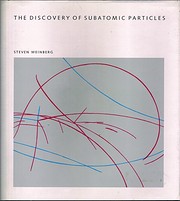

Fai clic su di un'immagine per andare a Google Ricerca Libri.
|
Sto caricando le informazioni... La scoperta delle particelle subatomiche (1983)di Steven Weinberg
 Nessuno Sto caricando le informazioni...
Iscriviti per consentire a LibraryThing di scoprire se ti piacerà questo libro. Attualmente non vi sono conversazioni su questo libro.  nessuna recensione | aggiungi una recensione
Appartiene alle SerieAppartiene alle Collane Editoriali
In this absorbing commentary on the discovery of the atom's constituents, Steven Weinberg accomplishes a brilliant fusion of history and science. This is in effect two books, cleverly interwoven. One is an account of a sequence of key events in the physics of the twentieth century, events that led to the discoveries of the electron, proton and neutron. The other is an introduction to those fundamentals of classical physics that played crucial roles in these discoveries. Physical concepts are introduced where needed to understand the historical story, and each new concept builds on physics already explained. Throughout the book, connections are shown between the historic discoveries of subatomic particles and work today at the frontiers of physics. A final chapter describes the discoveries of new elementary particles up to the present day. Non sono state trovate descrizioni di biblioteche
|
Discussioni correntiNessunoCopertine popolari
 Google Books — Sto caricando le informazioni... Google Books — Sto caricando le informazioni...GeneriSistema Decimale Melvil (DDC)539.7Natural sciences and mathematics Physics Matter; Molecular Physics; Atomic and Nuclear physics; Radiation; Quantum Physics Atomic and nuclear physicsClassificazione LCVotoMedia: (4.13) (4.13)
Sei tu?Diventa un autore di LibraryThing. |
||||||||||||||||||||||||||||||||||||||||||||||||||||||||||||||||||||||||||||||||||||||||||||||||||||||||||||||||||||||||||||||||